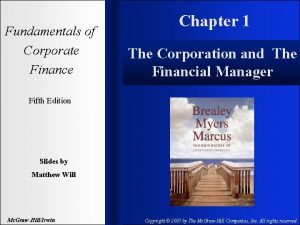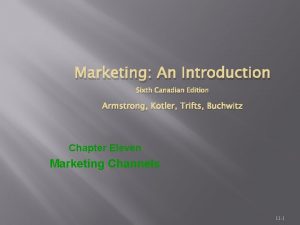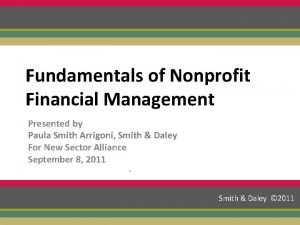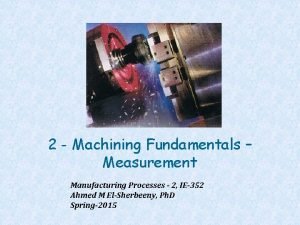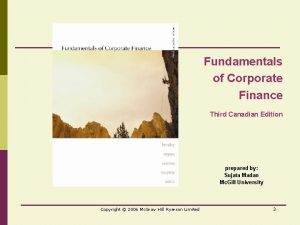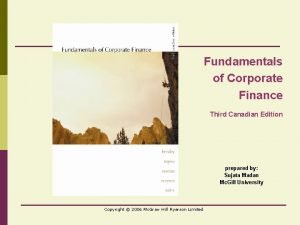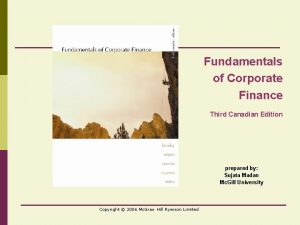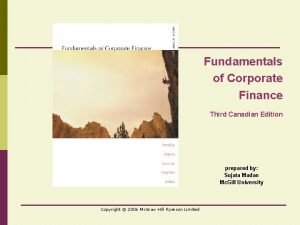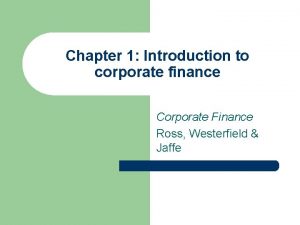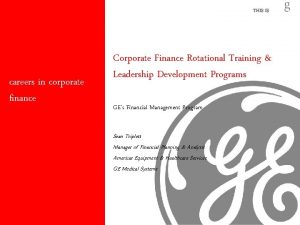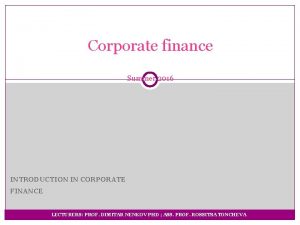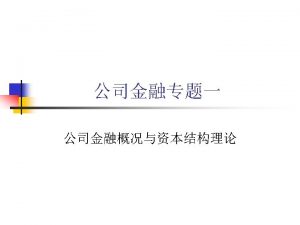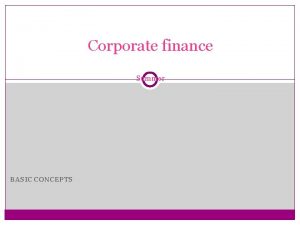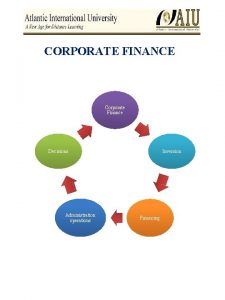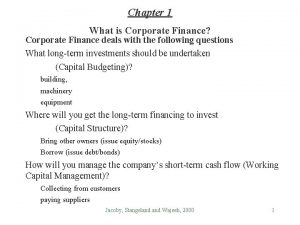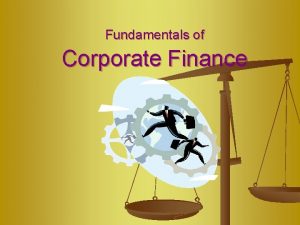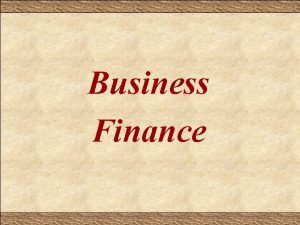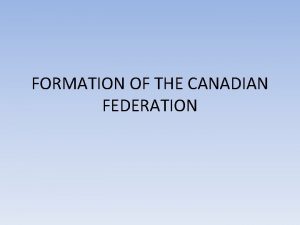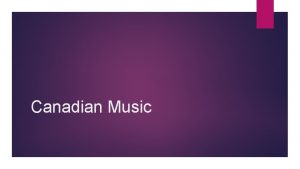Fundamentals of Corporate Finance Third Canadian Edition prepared



























- Slides: 27

Fundamentals of Corporate Finance Third Canadian Edition prepared by: Sujata Madan Mc. Gill University Copyright © 2006 Mc. Graw Hill Ryerson Limited 2 -

Chapter 5 Valuing Bonds n Bond Characteristics n Bond Prices and Yields Copyright © 2006 Mc. Graw Hill Ryerson Limited 2 -2 2

Bond Characteristics n Terminology w Governments and corporations borrow money for the long term by issuing securities called bonds. § § § The interest payment paid to the bondholders is called the coupon. The payment at the maturity of the bond is called the face value or par value. The date on which the loan will be paid off is the maturity date. Copyright © 2006 Mc. Graw Hill Ryerson Limited 2 -3 3

Bond Characteristics n Coupon Rate vs Discount Rate w w The coupon rate is the annual interest payment divided by the face value of the bond. The interest rate (or discount rate) is the rate at which the cash flows from the bond are discounted to determine its present value. Note: The coupon rate and the discount rate are NOT necessarily the same! Copyright © 2006 Mc. Graw Hill Ryerson Limited 2 -4 4

Bond Prices and Yields n Price of a bond w The price of a bond is the present value of all its future cash flows, that is, it is the present value of the coupon payments and the face value of the bond. w Careful…. . always discount the cash flows at the appropriate opportunity cost! Copyright © 2006 Mc. Graw Hill Ryerson Limited 2 -5 5

Bond Prices and Yields n Example w Calculate the current price of a 6. 5 % annual coupon bond, with a $1, 000 face value which matures in 3 years. Assume a required return of 5. 1%. 0 1 $65 2 3 $65 $1, 065 Copyright © 2006 Mc. Graw Hill Ryerson Limited 2 -6 6

Bond Prices and Yields n Example w Calculate the current price of a 6. 5 % annual coupon bond, with a $1, 000 face value which matures in 3 years. Assume a required return of 6. 5%. 0 1 $65 2 3 $65 $1, 065 Copyright © 2006 Mc. Graw Hill Ryerson Limited 2 -7 7

Bond Prices and Yields n Example w Calculate the current price of a 6. 5 % annual coupon bond, with a $1, 000 face value which matures in 3 years. Assume a required return of 15%. 0 1 $65 2 3 $65 $1, 065 Copyright © 2006 Mc. Graw Hill Ryerson Limited 2 -8 8

Bond Prices and Yields n. How Bond Prices Vary with Interest Rates Coupon Rate 6. 5% Interest Rate 5. 1% 6. 5% 15. 0% Price of Bond $1, 038. 05 $1, 000. 00 $ 805. 93 Notice that the price of a bond decreases with increasing interest rate. Copyright © 2006 Mc. Graw Hill Ryerson Limited 2 -9 9

Bond Prices and Yields n How Bond Prices Vary with Interest Rates Copyright © 2006 Mc. Graw Hill Ryerson Limited 2 -10 10

Bond Prices and Yields n Semi-annual coupon payments w Calculate the current price of a 6. 5 % semi-annual coupon bond, with a $1, 000 face value which matures in 3 years. Assume a required return of 6%. § § § Semi-annual coupon payments implies that the annual coupon payment is paid in two equal installments, every six months. Thus, the time line must be in six-month periods. And, you need to compute the six-month required return. Copyright © 2006 Mc. Graw Hill Ryerson Limited 2 -11 11

Bond Prices and Yields n Semi-annual coupon payments w Calculate the current price of a 6. 5 % semi-annual coupon bond, with a $1, 000 face value which matures in 3 years. Assume a required return of 6%. 0 1 $32. 50 2 $32. 50 3 $32. 50 4 $32. 50 5 $32. 50 Copyright © 2006 Mc. Graw Hill Ryerson Limited 6 $1, 032. 50 2 -12 12

Bond Prices and Yields n. Notice…. w When the coupon rate is equal to the required return, the bond sells at face value [at par]. w When the coupon rate is higher than the required return, the bond sells above face value [at a premium]. w When the coupon rate is lower than the required return, the bond sells below face value [at a discount]. Copyright © 2006 Mc. Graw Hill Ryerson Limited 2 -13 13

Bond Prices and Yields n. More terminology w Current Yield: Annual coupon payments divided by bond price. w Yield To Maturity: Interest rate for which the present value of the bond’s payments equal the price. w Rate of Return: Earnings period per dollar invested. Copyright © 2006 Mc. Graw Hill Ryerson Limited 2 -14 14

Bond Prices and Yields n Current Yield w w Current Yield = Coupon Payments Bond Price You are buying a bond with: § § Coupon Payments = $100 per year. Price of $1, 136. 16. Current Yield = $100 $1, 136. 16 = 0. 088 = 8. 8% Copyright © 2006 Mc. Graw Hill Ryerson Limited 2 -15 15

Bond Prices and Yields n Yield to Maturity w Yield to maturity is defined as the discount rate which makes the PV of the bond’s cash flows equal to its price. Copyright © 2006 Mc. Graw Hill Ryerson Limited 2 -16 16

Bond Prices and Yields n Yield to Maturity w A 3 -year, 10% annual coupon bond, with a face value of $1, 000 sells for $1, 136. 16. Solving for r, we calculate the YTM to be 5% Copyright © 2006 Mc. Graw Hill Ryerson Limited 2 -17 17

Bond Prices and Yields When Price = $1, 136. 16 the discount rate = 5% (ytm is 5%) Copyright © 2006 Mc. Graw Hill Ryerson Limited 2 -18 18

Bond Prices and Yields n. Rate w of Return You buy a $1, 000 par, 3 -year, 10% annual coupon bond for $1, 136. 16. One year later, you sell it for $1, 130. Rate of return = coupon income + price change investment = $100 + ($1, 130 - $1, 136. 16) $1, 136. 16 © 2006 Hill Ryerson Limited =Copyright 0. 083 =Mc. Graw 8. 3% 2 -19 19

Bond Prices and Yields n Interest Rate Risk w Interest rate risk is the risk in bond prices due to fluctuations in interest rates. w Different bonds are affected differently by interest rate changes. Copyright © 2006 Mc. Graw Hill Ryerson Limited 2 -20 20

Interest Rate Risk 30 yr bond When the interest rate equals the 6. 5% coupon rate, both bonds sell at face value 3 yr bond Copyright © 2006 Mc. Graw Hill Ryerson Limited 2 -21 21

Bond Prices and Yields n Default Risk w Both corporations and the Government of Canada borrow money by issuing bonds. § § Corporate borrowers can run out of cash and default on their borrowings. The Government of Canada cannot default – it just prints more money to cover its debts. Copyright © 2006 Mc. Graw Hill Ryerson Limited 2 -22 22

Bond Prices and Yields n Default Risk w Default risk (or credit risk) is the risk that a bond issuer may default on its bonds. w The default premium or credit spread is the difference between the promised yield on a corporate bond and the yield on a Canada bond with the same coupon and maturity. Copyright © 2006 Mc. Graw Hill Ryerson Limited 2 -23 23

Bond Prices and Yields n Default Risk w w The safety of a corporate bond can be judged from its bond rating. Bond ratings are provided by companies such as: § § § Dominion Bond Rating Service (DBRS). Moody’s. Standard and Poor’s. Copyright © 2006 Mc. Graw Hill Ryerson Limited 2 -24 24

Bond Prices and Yields n. Default Risk w Bonds rated BBB and above are called investment grade bonds. w Bonds rated BB and below are called speculative grade, high yield, or junk bonds. Copyright © 2006 Mc. Graw Hill Ryerson Limited 2 -25 25

Summary of Chapter 5 w w Coupon rate is the bond’s coupon divided by its face value. Current yield is the bond’s coupon divided by its current price. Yield to maturity measures the average return to an investor who purchases the bond and holds it until maturity. Bond prices and yield to maturity vary inversely. Copyright © 2006 Mc. Graw Hill Ryerson Limited 2 -26 26

Summary of Chapter 5 w Bond prices fluctuate in response to changes in interest rates. This risk of price change is called interest rate risk. § Long term bonds have greater interest rate risk than short term bonds. Investors use bond ratings to determine the risk of default on a bond. w The additional return that investors demand for bearing credit risk is called the default premium. w Copyright © 2006 Mc. Graw Hill Ryerson Limited 2 -27 27
 Fundamentals of corporate finance canadian edition
Fundamentals of corporate finance canadian edition Sujata madan
Sujata madan Fundamentals of corporate finance fifth edition
Fundamentals of corporate finance fifth edition Fundamentals of corporate finance 6th edition
Fundamentals of corporate finance 6th edition Fundamentals of corporate finance chapter 6 solutions
Fundamentals of corporate finance chapter 6 solutions Fundamentals of corporate finance, chapter 1
Fundamentals of corporate finance, chapter 1 Fundamentals of corporate finance, chapter 1
Fundamentals of corporate finance, chapter 1 Objectives of corporate finance
Objectives of corporate finance Corporate finance tenth edition
Corporate finance tenth edition Corporate finance tenth edition
Corporate finance tenth edition Corporate finance tenth edition
Corporate finance tenth edition Corporate finance tenth edition
Corporate finance tenth edition Corporate finance tenth edition
Corporate finance tenth edition Marketing an introduction 6th canadian edition
Marketing an introduction 6th canadian edition Accounting principles second canadian edition
Accounting principles second canadian edition Accounting principles second canadian edition
Accounting principles second canadian edition Accounting principles second canadian edition
Accounting principles second canadian edition Accounting principles second canadian edition
Accounting principles second canadian edition Class 6 cavity
Class 6 cavity Gj mount classification of caries
Gj mount classification of caries Finance fundamentals for nonprofits
Finance fundamentals for nonprofits Real estate finance fundamentals
Real estate finance fundamentals Fundamentals of information systems 9th edition
Fundamentals of information systems 9th edition Fundamentals of information systems 9th edition
Fundamentals of information systems 9th edition Fluid mechanics fundamentals and applications
Fluid mechanics fundamentals and applications Digital fundamentals by floyd 10th edition
Digital fundamentals by floyd 10th edition Machining fundamentals 10th edition
Machining fundamentals 10th edition Fundamentals of organizational communication
Fundamentals of organizational communication






